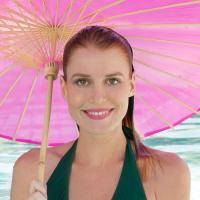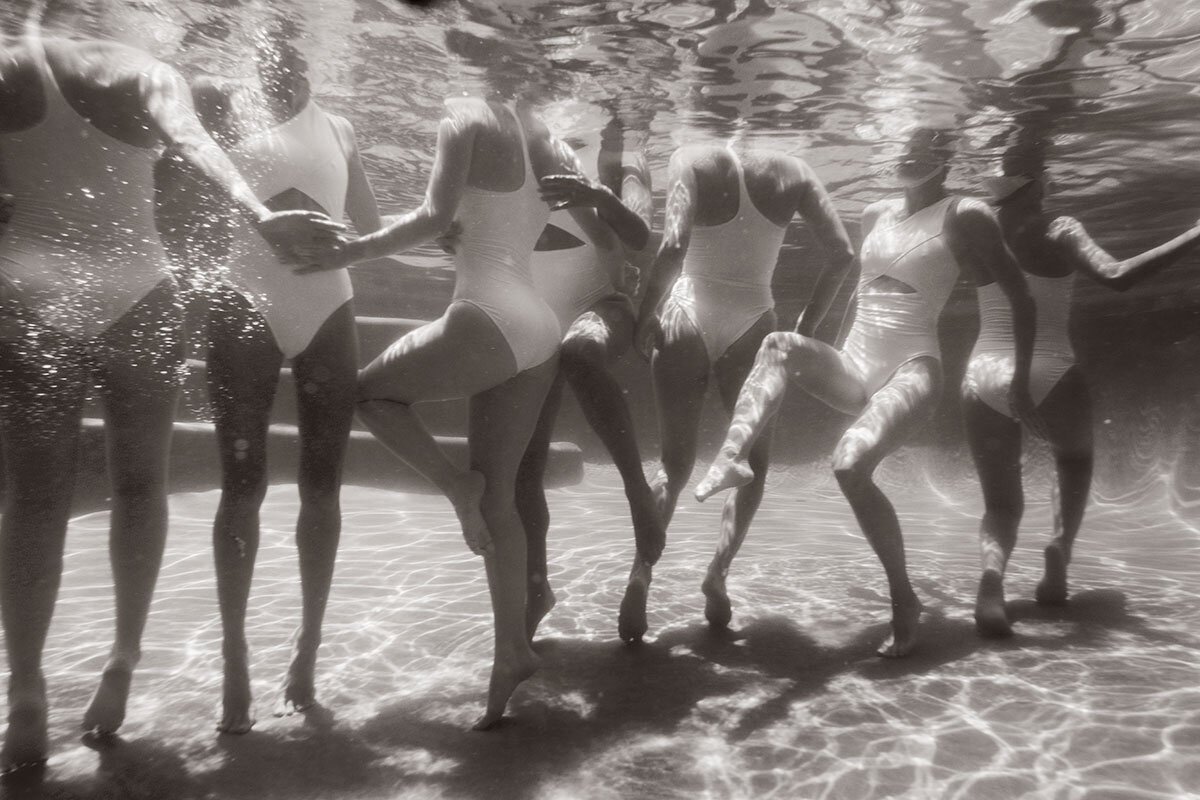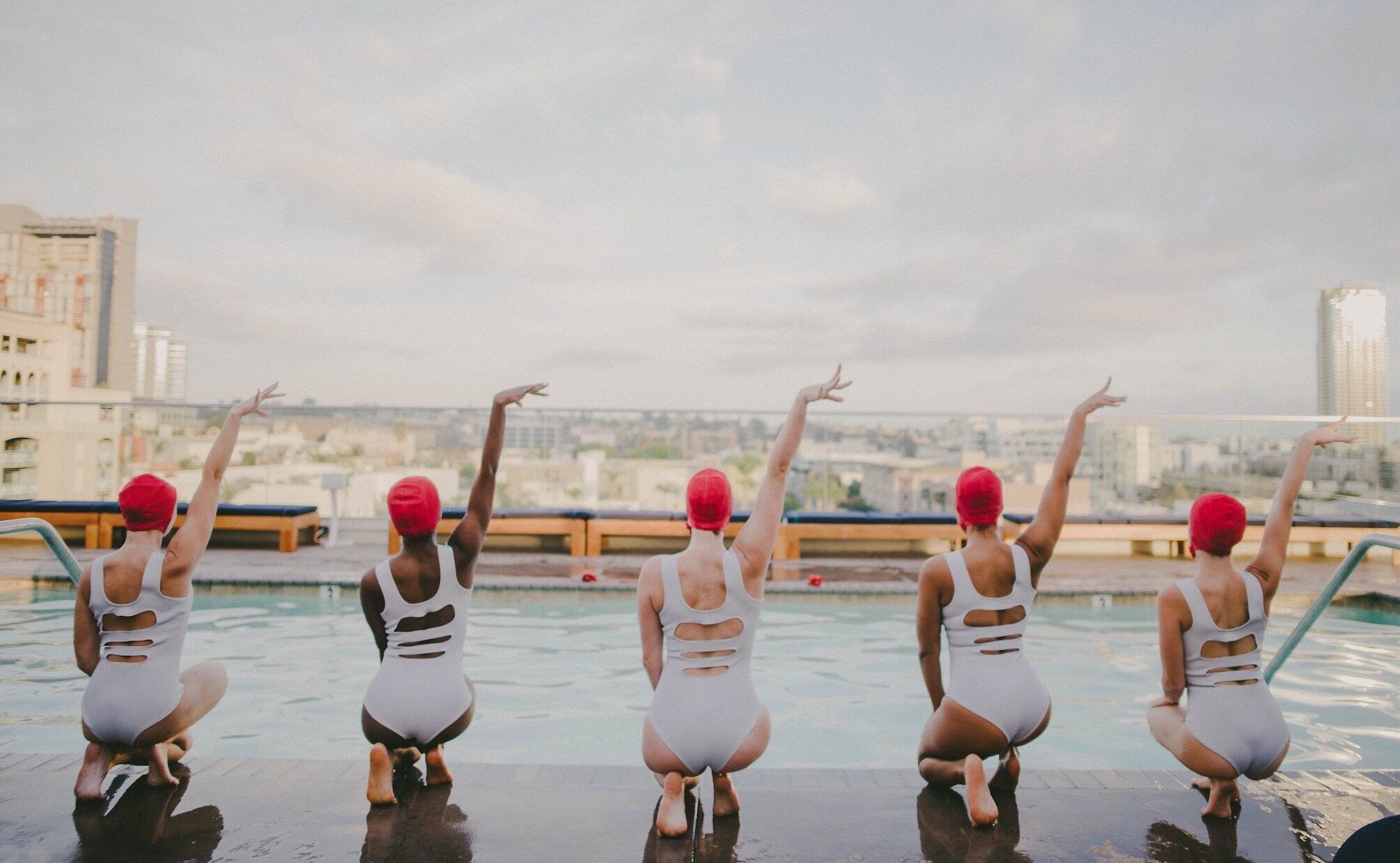COMPANY
Aqualillies is the world’s most glamorous water entertainment company, reinventing the classic art form for the new millennium. Diving off the pages of Vogue, Marie Claire and The New York Times, Aqualillies has become synonymous with beauty, sophistication, luxury, and style. In front of the camera or at live events for clients such as the Coen Brothers, The Marvelous Mrs. Maisel, Beyoncé, Ariana Grande, The Kardashians, Visa, Adidas, and Chanel, Aqualillies inspires audiences with innovative spectacles of romance, athleticism and grace.
MISSION STATEMENT
Our goal is to inspire people with beauty, grace, and spectacle, bringing to life the magic of the universe through artistic swimming and dance. By following our dreams we hope to encourage others do the same: to free their imagination, seek out adventure, believe in themselves and their power to make the world a better place. We are reinventing water ballet for the new millennium!

Mesha Kussman (Founder & Artistic Director) received a BFA from NYU’s Tisch School of the Arts in Experimental Theater where she studied dance technique, choreography and directing. She began her career creating high concept dance-theater work for the performance art scene in Downtown, NY. In 2003, she moved to Los Angeles where her expressive visual style gained a commercial home when she founded Aqualillies. Most recently her work has been featured in The Coen Brother’s Hail Caesar!, Glee, TED and music videos from Justin Bieber & Nicki Minaj to Sébastien Tellier.

Mary Jeanette Ramsey (Executive Director) Inspired by teamwork, sparkles and smiles, Mary started synchronized swimming at age 6 and quickly became hooked on the unique and demanding sport. She competed on a national and international-level and then followed her love of the water back east to study Art History and swim at the College of William and Mary. From there it was on to the University of Southern California Gould School of Law to get her J.D. in 2012 with a specialization in entertainment law. Working at Aqualillies is Mary’s dream exhibit, the perfect blend of artistry, athleticism and her passion for the water. She was Scarlett Johansson’s mermaid trainer and body double in Hail, Caesar!, and choreographed splashy moves for Disney, TNT’s Claws, Morton Salt, Missy Elliott and more.

Carla Ni (Production & Social Media) grew up synchronized from birth, as an identical twin with a shared love for water. Carla was a nationally competitive synchronized swimmer before joining Aqualillies. Driven by her endless curiosity, careful eye to detail, and innate passion for creating joyful memories, Carla found a natural home with Aqualillies on-site at events. As the Production Coordinator and occasional performer, Carla is able to pursue all of her interests at the intersection of art, movement, and fashion: she’s made a splash in diamond jewelry for Hermès, travelled from Sedona to St. Barth’s, and been published in Vogue through Aqualillies.

Jasmine Hendrix (Accounting) is a forensic psychologist currently working with a Los Angeles County program that integrates women back into society after incarceration. Jasmine has a passion for preventative measures for at risk youth and working to bridging the gap between the justice system and mental health. In college Jasmine worked as a bookkeeper, which lead to her own passion and love for numbers and accounting. She has continued in accounting and bookkeeping to perform this vital role within our company.

Francesca Owen (Australia) Francesca “Frankie” is a photographic artist and Manager of the Aqualillies Australian Team. Frankie’s intrigue for the water began at age eight when she was introduced to artistic swimming. In 2012, she was selected to represent Australia in the London Olympics Games. After hanging up her competitive gear, she picked up her underwater housing and camera, and hasn’t left the waters edge since. Having studied Photojournalism at University, Francesca was able to merge her two passions and creates underwater art for that graces the walls of hotels and homes in Byron Bay, Paris and New York. Some of her favorite past events include an appearance for Cosmo Magazine in Sydney and an exclusive gala for Chopard Jewelry in Singapore.

Samantha Larose and Dan Berry (Canada)
The Movement Talent Agency
4605 Lankershim Blvd. #340
North Hollywood, CA 91602
Jim Keith
323.462.5300
jim@movement-agency.com
For all on-camera and live event performance inquiries, please Contact Us using the form below to get in touch at booking@aqualillies.com.

DIVERSITY & INCLUSION IN ARTISTIC SWIMMING
Aqualillies is about beauty, strength and grace through inclusion and equity. It is important for us to be a platform that represents our values, and we are committed to taking ongoing action for change. Our company pledges to actively contribute to the larger conversation and plans to diversify the pool both within our company and in the greater aquatics community; to call out injustices when we hear or see them both within our company and community; to donate to causes that support Black Indigenous & People of Color; to use our platform to champion and promote Black and POC performers and artists; and to continue fighting for justice and equality through the ongoing work for learning, listening, and taking action.
“When water sports roll into the spotlight every four years around the Olympic Games, it’s striking how few Black athletes are competing at the highest level, including for the U.S. Officials at national governing bodies for water sports—swimming, diving, water polo and artistic swimming—acknowledge the obvious: their sports are perceived as very white, with few Hispanic, Asian-American and Pacific Islander swimmers and even fewer Blacks. After years of exploring community outreach efforts, those organizations in 2020 moved to create formal structures that would help them diversity amid the national reckoning over race in the aftermath of the murder of George Floyd.” — Wall Street Journal. Access to swimming pools and water safety remains a major issue in the Black Indigenous and Person of Color community; and Black Indigenous and Person of Color athletes, as well as Athletes with Disabilities (AWD), are underrepresented in artistic swimming and other elite aquatic sports.
LEARN MORE
History: Swimming Pools in the United States
(Excerpts from Contested Waters: A Social History of Swimming Pools in America published with permission from author Jeff Wiltse).
“Swimming pools have long been contested spaces where Americans define the social boundaries of community life. Americans have fought over where pools should be built, who should be allowed to use them, and how they should be used. How these questions have been answered over the past 150 years reveals much about the power of social prejudices in American society and the persistence of racial inequality.
The earliest public pools were built in large northern cities during the late 19th and early 20th centuries. They served mostly poor and working-class boys— both Black and white—and reveal the class prejudices of the time. In 1910, for example, the proposal to build a large municipal pool in New York’s Central Park generated intense opposition from the city’s middle and upper classes, because it would attract large numbers of immigrant and working-class kids into their oasis of genteel recreation. “I should consider it disastrous if the only swimming pool belonging to the city was put [in Central Park],” one critic told the New York Times. “It would attract all sorts of undesirable people.” The paper agreed and recommended that municipal pools be located underneath the Manhattan and Queensboro bridges. These locations would have effectively secluded working-class swimmers, thereby protecting the city’s class-segregated social geography.
The design of pools and the social composition of swimmers fundamentally changed during the 1920s and 1930s, when cities across the country built large, resort like swimming pools and allowed males and females to use them together for the first time. In northern cities such as Chicago, New York and Pittsburgh, this gender integration brought about racial segregation. Public officials and white swimmers now objected to the presence of Black Americans, because they did not want Black men interacting with white women at such visually and physically intimate spaces. At the same time, the first wave of the Great Black Migration intensified other racist prejudices. Northern whites generally perceived the Black southern migrants settling in northern cities as physically unclean and likely to be infected with communicable diseases. This made them unwilling to share an enclosed body of water with Black Americans for fear of contracting a communicable disease from them or being contaminated by their supposed dirtiness. And so, throughout the North, public pools became racially segregated during the interwar years. In some cases, white swimmers imposed de facto segregation through violence and intimidation. At Pittsburgh’s Highland Park Pool, white swimmers attacked Black swimmers—sometimes with rocks and clubs—to prevent them from entering the pool. Police officers encouraged these attacks and even arrested the Black victims, charging them with “inciting to riot.” In attempting to explain why Black swimmers were being attacked at Highland Park Pool, the Pittsburgh Courier wrote: “The whole trouble seems to be due to the way Highland Park Pool is operated. It is the only city pool where men and women, girls and boys swim together. This brings the sex question into the pool and trouble is bound to arise between the races.”
The same type of trouble had no chance to arise at public swimming pools in the South and in border-state cities such as St. Louis and Baltimore, because public officials mandated racial segregation, explicitly barring Blacks from entering “whites-only” pools. St. Louis, for example, opened seven municipal pools between 1913 and 1935, two of which were giant leisure resorts with circular pools measuring several hundred feet in diameter. All seven of these pools were for whites only. Finally, in 1936, the city opened a pool for Black residents. Unlike the ones available to whites, the Jim Crow pool was small and lacked leisure space. Not surprisingly, it attracted comparatively few swimmers. Across the country, public swimming pools were racially desegregated after World War II, but that was met with widespread opposition from whites that again exposed their social prejudices. Southern cities typically shut down their public pools rather than allow mixed-race swimming. In the North, whites generally abandoned pools that became accessible to Blacks and retreated to ones located in thoroughly white neighborhoods or established private club pools, where racial discrimination was still legal. Warren, Ohio, for example, was forced by a pending court order to desegregate its municipal pool in 1948. The local newspaper covered the first day of interracial swimming by printing a front-page photo showing a dozen children waiting to enter. The last two children in line were Black; the caption read: “Last one in the water is a monkey.” The racial antipathy expressed in the newspaper was shared by many local whites, who stopped using the pool when they realized Black residents intended to use it. Similarly, in 1962, several years after Pittsburgh’s municipal pools were desegregated, a sign posted outside a city pool still used exclusively by whites read, “No dogs or niggers allowed.” In some cases, whites violently resisted desegregation. The day after St. Louis officials announced in 1949 that the city would no longer enforce racial segregation at its municipal pools, a white mob numbering in the thousands gathered outside Fairground Park Pool and viciously attacked each identifiably Black person who came near. A local newspaper described one of the assaults: “At 7:50 pm a Negro was seen on the east side of Spring Street, and another chase was underway. He ran, stumbled, and fell about 100 feet west of Grand Avenue. Members of the crowd pounced on the Negro, beating him severely.” When Black residents finally gained safe access to Fairground Park Pool a year later, white swimmers abandoned it en masse. The city closed the enormous pool a few years later.
Public officials briefly prioritized the recreational needs of Black Americans during the late 1960s. In response to the violent protests that erupted in New York, Watts, Newark, Detroit, Chicago, and many other Americans cities between 1964 and 1968, the federal government funded hundreds of swimming pools for inner-city residents of “troubled neighborhoods.” Providing summer recreation for urban Blacks suddenly became a national priority. And yet, most of the municipal pools opened during this building spree were “mini-pools,” measuring only 20 by 40 feet and uniformly 3 feet deep. They did not provide viable recreation or encourage actual swimming. Children mostly stood in the water splashing. Nor did the mini-pools provide any leisure space. The tanks were surrounded by a narrow concrete perimeter and enclosed by a chain-link fence. Most did not even have changing rooms, so swimmers traveled to and from the pools in their swimsuits. Children in one New York neighborhood dubbed them “giant-sized urinals.” The “mini-pool” building spree of the late 1960s was short lived. Whereas urban public pools had briefly been a national priority, pool building stalled during the next several decades. The primary reasons were economic. Ballooning budget deficits and the threat of bankruptcy forced many cities to abandon plans for new pools and put off costly maintenance and repairs on existing pools. A wave of pool closures followed. Youngstown, Ohio, closed 6 of its 8 municipal pools between 1985 and 1991. Pittsburgh closed 20 of its 32 municipal pools between 1996 and 2004. The remnants of these empty pools exemplified the urban crisis of poverty and public neglect. As the Detroit News described the state of McCabe Pool in 1989, “Boards have replaced broken windows. The water fountain is broken. Walls are smeared with graffiti. The ground is littered and a burned car sits in the parking lot.”
Contemporary Aquatic Sports
In recent times, many swimming pools continue to be racially divided and contested spaces. In 2009, 65 Black and Latino campers from the Creative Steps Day Camp in North Philadelphia arrived at the Valley Swim Club in suburban Montgomery County to play for an hour and a half. Camp director Althea Wright had paid the private club $1,950 to use the facility Monday afternoons throughout the summer. As the campers entered the water, some club members reportedly pulled their children from the pool and wondered aloud what all these Black and Latino kids were doing there. A few days later, the Valley Swim Club canceled the lease agreement. When pressed to explain, the club president stated, “There was concern [among the members] that a lot of kids would change the complexion … and the atmosphere of the club.” Several racially charged confrontations occurred at swimming pools during the summer of 2018. In one instance, a white woman physically assaulted a 15-year-old Black boy at a private community pool in Summerville, South Carolina, claiming he and his friends “didn’t belong” there, then exclaiming, “Get out, little punks!” A couple weeks later in Winston-Salem, North Carolina, a white man singled out the only Black family at a crowded community pool and demanded to see the mother’s “identification.” When she refused, the man called the police. That same day, 555 miles away in Memphis, Tennessee, the manager of a large apartment complex engaged in a similar act of racial profiling. Even though several other people were wearing prohibited clothing in the pool area, the manager only confronted the lone group of Black swimmers. She reprimanded 25-year-old Kevin Yates for dipping his sock-clad feet in the water and eventually demanded that he and his party leave the pool. When they refused, she, too, called the police. The common thread in all three of these confrontations was a white person’s assumption Black people do not belong at swimming pools, at least not the same pools that whites use.
Why have swimming pools in the United States been such contentious and contested community spaces? Part of the answer has to do with the uniqueness of swimming pools as physical spaces. They are visually and socially intimate. Swimmers gaze upon one another’s nearly naked bodies, lie in the sun next to one another, navigate through crowded water, and flirt. This type of contact and interaction piques social anxieties and exposes the lack of trust and understanding between people of different social groups. Swimming pools have also been intensely contested because they are places at which people build community and define the social boundaries of community life. Swimming pools are primary summertime gathering places, where many people come together (often for several hours), socialize, and share a common space. Swimming with others in a pool means accepting them as part of the same community precisely because the interaction is so intimate and sociable. Conversely, excluding someone or some group from a pool effectively defines them as social others—as excluded from the community. For these reasons, swimming pools serve as useful barometers of social relations. If we as a nation want to know how we relate to one another across social lines, how we structure our communities socially, and how we think about people who are socially different from ourselves, just look at our swimming pools. The answers will be obvious.¹
This has obvious implications when it comes to safety. “According to reports from the Centers for Disease Control and Prevention, Black children and teenagers are almost six times as likely as white children to drown in a swimming pool. USA Swimming reports that 69% of Black children have little to no swimming ability, compared with 42% of white children. For many Black individuals and families, the answer to these growing disparities has been to avoid the water altogether or to stay in the shallow end or to pretend to be able to swim when forced into the water. But these self-protections fall short when the unexpected, and sometimes tragic, happens.”²
Within the world of contemporary sports, “When water sports roll into the spotlight every four years around the Olympic Games, it’s striking how few Black athletes are competing at the highest level, including for the U.S. Officials at national governing bodies for water sports—swimming, diving, water polo and artistic swimming—acknowledge the obvious: their sports are perceived as very white, with few Hispanic, Asian-American and Pacific Islander swimmers and even fewer Blacks. After years of exploring community outreach efforts, those organizations in 2020 moved to create formal structures that would help them diversity amid the national reckoning over race in the aftermath of the murder of George Floyd.³
“We took a really long hard look at ourselves and said, ‘We need to change this look,’ ” said Ashley Johnson, USA Artistic Swimming’s vice president for diversity, equity and inclusion, a position established last summer. I want to be able to see and know that my child would be accepted into the organization.” She added: “You want to be and see where there are others that look like you… you don’t want to be in an organization where you are the only one.” There is also a movement to help introduce Athletes with Disabilities (AWD) in Artistic Swimming into more competitions so that athletes with disabilities/special needs (AWD) can compete at higher/elite levels. Currently, this involves a movement to integrate Artistic Swimming into the Paralympic Games.
¹ Wiltse, Jeff. Contested Waters: A Social History of Swimming Pools in America. New edition, The University of North Carolina Press, 2010.
² Prizzia, Victoria A. “Pool: A Social History of Segregation.” Pool Magazine, https://www.poolphl.com/pdfs/Pool_Magazine.pdf.
³ Higgins, Laine, and Louise Radnofsky. “The World of Olympic Water Sports Still Looks Very White. There’s a Push to Change That.” The Wall Street Journal, 12 Aug. 2021.
GET INVOLVED
Learn and spread the word. Understand and educate others about the history of swimming pools in the US and the continuing lack of diversity in aquatic sports. Your voice makes a difference! Resources we recommend:
- Contested Waters: A Social History of Swimming Pools in America. by Jeff Wiltse. New edition, The University of North Carolina Press, 2010.
- POOL: A Social History of Segregation is an immersive blend of interactive media, site-specific artworks, arresting graphics, and powerful stories that bring the history of segregated swimming and its reverberations to life.
- Crossing The Lane Lines is a Podcast dedicated to giving voice to the Black Swim community. Connecting with coaches, swimmers, authors and activists, the podcast seeks to inform the public about the rich aquatic history of the Black diaspora.
Contribute. You can contribute financially to causes that support diversity and inclusion within artistic swimming:
- Artistic Swim AWD is a 501(c)(3) Non Profit Organization committed to supporting communities under-represented in artistic swimming in the United States, including athletes with disabilities and Black Indigenous & People of Color athletes.
- Diversity In Aquatics is an organization built to develop a network to help save lives by empowering communities to have equitable access to quality aquatic opportunities.
- Swim Up Hill, founded by Team USA Paralympian Jamal Hill, is a social justice driven 501(c)(3) non-profit organization that provides specialized swim education tailored to the specific needs of low-to-middle income communities, which continue to be affected by disproportionately high drowning rates.

CAUSES WE SUPPORT
Through one-time donations, ongoing monthly donations, volunteer time donations, and live performance donations, learn more about the organizations and causes we support below.
USA ARTISTIC SWIMMING (formerly USA Synchro) is a non-profit organization that is the governing body for artistic swimming in the United States. USAAS organizes, participates in, and promotes a variety of competitive events each year. These events begin at the local level and continue in the following categories: Age Group (12-19), Junior (15-18), Senior and Masters (20+). Learn more here.
ARTISTIC SWIM AWD is a 501 (c) 3 Non Profit Organization committed to supporting communities under-represented in artistic swimming in the United States, including athletes with disabilities and Black Indigenous & People of Color athletes. Learn more here.
DIVERSITY IN AQUATICS is an organization built to develop a network to help save lives by empowering communities to have equitable access to quality aquatic opportunities. Learn more here.
SWIM UP HILL was founded by Team USA Paralympian Jamal Hill, is a social justice driven 501(c)(3) non-profit organization that provides specialized swim education tailored to the specific needs of low-to-middle income communities, which continue to be affected by disproportionately high drowning rates. Learn more here.
GIRL UP is the United Nations Foundation’s adolescent girl campaign that engages girls to stand up for girls by empowering each other and changing our world. Led by a community of passionate advocates raising awareness and funds, our efforts help the hardest to reach girls living in places where it is hardest to be a girl. Girls are powerful. When they’re educated, healthy, safe, and counted, they transform their communities. Learn more here.
OCEANIC GLOBAL is an international non-profit that sheds light on humanity’s essential relationship to the ocean to empower individuals, communities, and industries to create positive change for our collective wellbeing. Oceanic Global was one of the partners on “From Sea to Rising Sea”, the 2021 virtual reality film we were featured in to inspire climate action. Learn more here.
OCEANA is the largest international advocacy organization focused solely on ocean conservation. They are dedicated to achieving measurable change by conducting specific, science-based policy campaigns with fixed deadlines and articulated goals. Learn more here.
SIMA is a 501(c)3 tax-exempt arts organization that advances global awareness, social justice, human rights and education by supporting content creators, activists, educators and changemakers on the front-lines of social change, and amplifying the impact of their works to inspire activism, compassion and social transformation. SIMA Studios was one of the partners on “From Sea to Rising Sea”, the 2021 virtual reality film we were featured in to inspire climate action. Learn more here.
SEE MORE
SWIM WITH HEART is a non-profit organization that offers year-round swim instruction and competitive swim team training to residents of the Santa Monica and the surrounding areas. We have performed at their annual Gala in 2014, 2017, and 2019. You can get involved and learn more here.
HEAL THE BAY is dedicated to making the coastal waters and watersheds of Greater Los Angeles safe, healthy and clean! We loved making a splash at their Gala in 2011. You can get involved and learn more here.
THE NAACP LEGAL DEFENSE AND EDUCATIONAL FUND uses litigation, advocacy, and public education to work towards racial justice and equality for all Americans. The organization is fighting to protect voting rights, reform the criminal justice system, and improve equal access to education, among other civil rights causes. Learn more here.
EQUAL JUSTICE INITIATIVE is committed to ending mass incarceration and excessive punishment in the United States, to challenging racial and economic injustice, and to protecting basic human rights for the most vulnerable people in American society. Learn more here.
COLOR OF CHANGE is the nation’s largest online racial justice organization. We help people respond effectively to injustice in the world around us. As a national online force driven by 1.7 million members, we move decision-makers in corporations and government to create a more human and less hostile world for Black people in America. Learn more here.
THE LOVELAND FOUNDATION was established by Rachel Cargle as an effort to bring opportunity and healing to communities of color, especially to Black women and girls, through fellowships, residency programs, listening tours, and more. The Loveland Foundation hopes to contribute to both the empowerment and the liberation of the communities they serve. Learn more here.
GLOBAL FUND FOR WOMEN uses their powerful networks to find, fund, and amplify the courageous work of women who are building social movements and challenging the status quo. Learn more here.
CHARITY: WATER is a non-profit organization that provides clean and safe drinking water to people in developing nations, with 100% of their public donations going towards funding for clean water projects. Learn more here.
NATIONAL WOMEN’S LAW CENTER are passionate champions of national and state policies and laws that help women and girls achieve their potential throughout their lives-at school, at work, at home, in their families, and in their communities. Learn more here.
KNOW YOUR RIGHTS CAMP is a free campaign founded by Colin Kaepernick. Their mission is to advance the liberation and well-being of Black and Brown communities through education, self-empowerment, mass-mobilization and the creation of new systems that elevate the next generation of change leaders. Learn more here.
GO CAMPAIGN raises awareness and funds to help orphans and vulnerable children throughout the world gain access to clean water, education, medical care, and basic human rights. We performed at the GO GO Gala (their annual Hollywood fundraiser) in 2011. You can get involved and learn more here.
LEUKEMIA & LYMPHOMA SOCIETY funds leading-edge research for every type of blood cancer, including leukemia, lymphoma, myeloma, and other rare types of blood cancers. LLS has invested nearly $1.3 billion in cancer research since 1949, leading to breakthroughs in immunotherapy, genomics and personalized medicine that are improving and saving the lives of patients. Learn more here.
DREAM FOUNDATION is the only national dream-granting organization in the United States for terminally-ill adults. Learn more here.
LINDA’S VOICE aims to “shatter the silence” to promote gender equality through education, activism, and economic development while helping put a stop to patriarchal violence. The Foundation provide resources to existing organizations in their efforts to end patriarchal violence and promote gender equality. Learn more here.
CONTRIBUTING CHOREOGRAPHERS:
- Mesha Kussman
- Mary Ramsey
- Deirdre Barnes
- Michelle Dawley
- Paige Ramsey
- Manon Boseggia
- Tori Evans
- Athena Perample
- Jannel Diaz
- Katya Frelikh
- Amberley Shaw
- Alia Arbas
- Kara Fioretti
- Nina Flagg
- Olivia Morgan
- Tawny Andersson
- Natsumi Miyazaki
SPECIAL THANKS
- Adrienne Campbell Holt
- Alysha Young
- Amanda Rowan
- Annenberg Community Beach House
- Candy Hipp
- Eva Puppinck
- Heidi Liou
- James Balsam
- Kacie Velie
- Molly Nourmand
- Meghan Manning
- Teresa Taylor
- Tina Shults
- Tracey McCall
- Vergi Rodriguez
- Vero Bollow & Miguel Sanchez
- World War Seven
- Larry and Sheri Ramsey
- Ashley Giesbrecht (Hair + Makeup)
- Blow Up Coiffure (Hair + Makeup)
- Marybeth Bagonghasa (Hair + Makeup)
- Alana Peterson (Hair + Makeup)
- Bella Rouge (Hair + Makeup)
- Sunil Kumar (Web/Software Developer)
